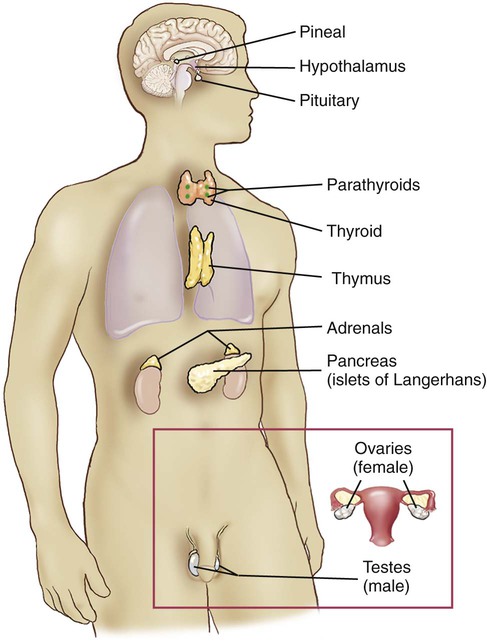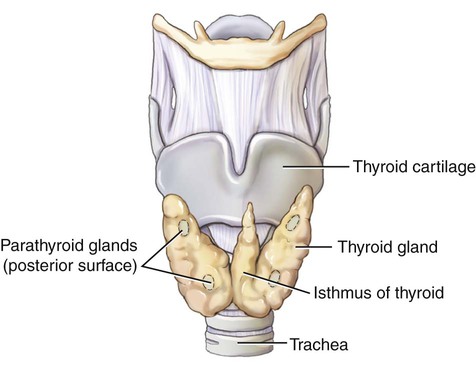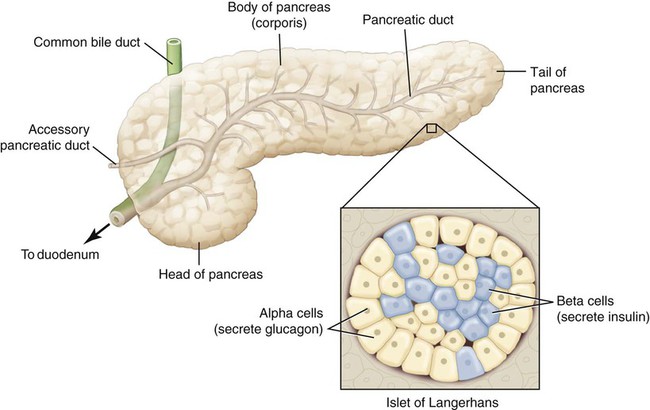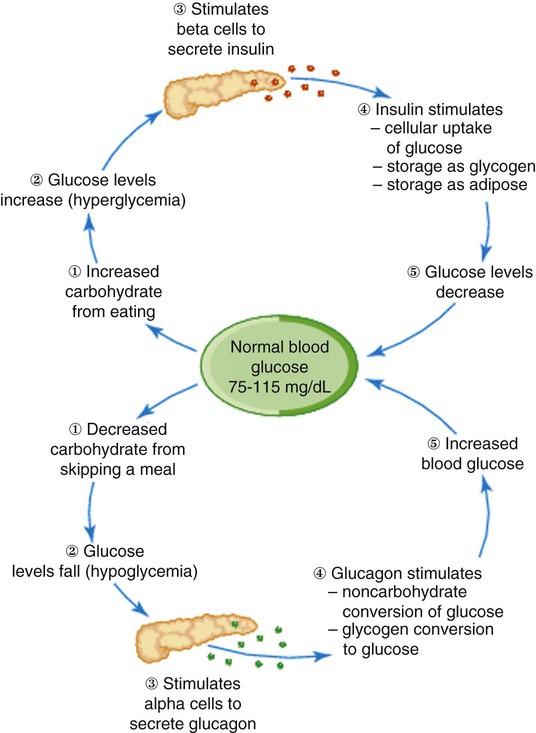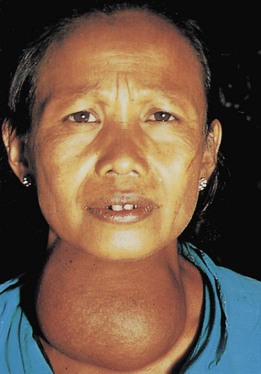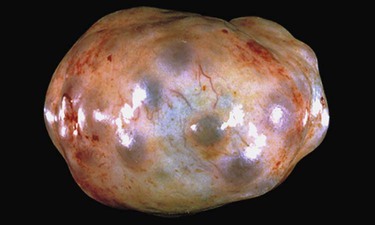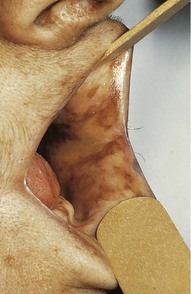The endocrine system is composed of several single and paired ductless glands that secrete hormones into the bloodstream. The hormones regulate specific body functions by acting on target cells with receptor sites for those particular hormones only. See Figure 15-1 for an illustration of the body with the locations of the endocrine glands. The anterior lobe, or adenohypophysis, is composed of glandular tissue and secretes hormones in response to stimulation by the hypothalamus. The hypothalamus sends hormones through blood vessels, which cause the adenohypophysis either to release or to inhibit the release of specific hormones. The adenohypophysis has a wide range of effects on the body, as Figure 15-2 and the table below illustrate. The posterior lobe (neurohypophysis) of the pituitary gland is composed of nervous tissue. The hormones that it secretes are produced in the hypothalamus, transported to the neurohypophysis directly through the tissue connecting the organs, and released from storage in the posterior lobe by neural stimulation from the hypothalamus. The two hormones released by this lobe are antidiuretic hormone (ADH) and oxytocin (OT). See the following table and Figure 15-2 for the hormones secreted by the neurohypophysis and their effects. Adenohypophysis Hormones and Their Effects Neurohypophysis Hormones and Their Effects The thyroid gland is a single organ, but is divided into right and left lobes that are joined by a thin structure termed the isthmus (Fig. 15-3). It is located in the anterior part of the neck and is bounded by the trachea behind it and the thyroid cartilage above it. It regulates the metabolism of the body and normal growth and development, and controls the amount of calcium (Ca) deposited into bone. The thyroid gland is composed of small sacs, called follicles, that absorb iodine. The sacs are surrounded by follicular cells that produce triiodothyronine (T3) and thyroxine (T4). Parafollicular cells in the thyroid produce and secrete calcitonin, which controls the amount of calcium in the blood. Thyroid-stimulating hormone (TSH), released by the anterior pituitary gland, causes the thyroid to release T3 and T4. Thyroid Gland Hormones and Their Effects The adrenal cortex secretes three hormones that are called steroids. Adrenal Cortex Hormones and Their Effects Adrenal Medulla Hormones and Their Effects The pancreas, located inferior and posterior to the stomach, is a gland with both exocrine and endocrine functions (Fig. 15-4). The exocrine function is to release digestive enzymes through a duct into the small intestines. The endocrine function, accomplished through a variety of types of cells called islets of Langerhans, is to regulate the level of glucose in the blood by stimulating the liver. The two main types of islets of Langerhans are alpha and beta cells. Alpha cells produce the hormone glucagon, which increases the level of glucose in the blood when levels are low. Beta cells secrete insulin, which decreases the level of glucose in the blood when levels are high. Insulin is needed to transport glucose out of the bloodstream and into the cells. In the absence of glucose in the cells, proteins and fats are broken down, causing excessive fatty acids and ketones in the blood. Normally, these hormones regulate glucose levels through the metabolism of fats, carbohydrates, and proteins. See Figure 15-5 for a diagram explaining the effects of insulin and glucagon. Combining Forms for the Anatomy and Physiology of the Endocrine System Prefixes for the Anatomy of the Endocrine System Suffixes for the Anatomy of the Endocrine System Terms Related to Signs and Symptoms of Endocrine Disorders (RØØ-R99)
Endocrine System and Nutritional and Metabolic Diseases
 Recognize and use terms related to the anatomy and physiology of the endocrine system.
Recognize and use terms related to the anatomy and physiology of the endocrine system.
 Recognize and use terms related to the pathology of the endocrine system.
Recognize and use terms related to the pathology of the endocrine system.
 Recognize and use terms related to the procedures for the endocrine system.
Recognize and use terms related to the procedures for the endocrine system.
Anatomy and Physiology
Pituitary Gland
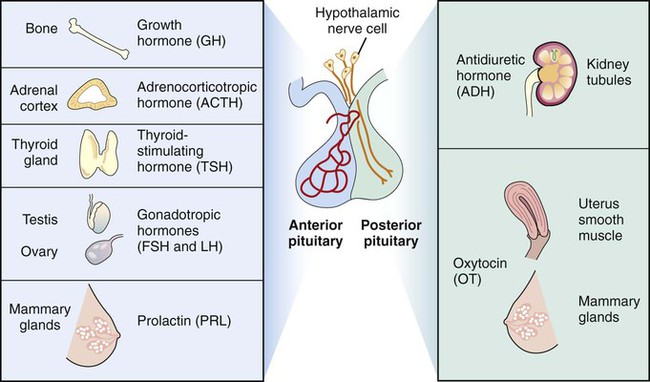
Adenohypophysis Hormones
Effect
Adrenocorticotropic hormone (ACTH)
Stimulates the adrenal cortex to release steroids.
Gonadotropic hormones (include follicle-stimulating hormone [FSH], luteinizing hormone [LH], and interstitial cell-stimulating hormone [ICSH])
FSH stimulates the development of gametes in the respective sexes. LH stimulates ovulation in the female and the secretion of sex hormones in both the male and the female. ICSH stimulates production of reproductive cells in the male.
Growth hormone (GH) (also called human growth hormone [hGH] or somatotropin hormone [STH])
Stimulates growth of long bones and skeletal muscle; converts proteins to glucose.
Prolactin (PRL) (also called lactogenic hormone)
Stimulates milk production in the breast.
Thyrotropin (also called thyroid-stimulating hormone [TSH])
Stimulates thyroid to release two other thyroid hormones.
Neurohypophysis Hormones
Effect
Antidiuretic hormone (ADH) (also called vasopressin)
Stimulates the kidneys to reabsorb water and return it to circulation; is also a vasoconstrictor, resulting in higher blood pressure.
Oxytocin (OT)
Stimulates the muscles of the uterus during the delivery of an infant and the muscles surrounding the mammary ducts to contract, releasing milk.
Thyroid Gland
Thyroid Gland Hormone
Effect
Calcitonin
Regulates the amount of calcium in the bloodstream.
Tetraiodothyronine (also called thyroxine [T4])
Increases cell metabolism.
Triiodothyronine (T3)
Increases cell metabolism.
Adrenal Glands (Suprarenals)
Adrenal Cortex Hormones
Effect
Glucocorticoids (e.g., cortisol [hydrocortisone])
Respond to stress; have antiinflammatory properties.
Mineralocorticoids (e.g., aldosterone)
Regulate blood volume, blood pressure, and electrolytes.
Sex hormones (e.g., estrogen, androgen)
Responsible for secondary sex characteristics.
Adrenal Medulla Hormones (Catecholamines)
Effect
Dopamine
Dilates arteries and increases production of urine, blood pressure, and cardiac rate. Acts as a neurotransmitter in the nervous system.
Epinephrine (also called adrenaline)
Dilates bronchi, increases heart rate, raises blood pressure, dilates pupils, and elevates blood sugar levels.
Norepinephrine (also called noradrenaline)
Increases heart rate and blood pressure and elevates blood sugar levels for energy use.
Pancreas
Pineal Body
Meaning
Combining Form
adrenal gland
adren/o, adrenal/o
calcium
calc/o, calc/i
cortex
cortic/o
gland
aden/o
glucose, sugar
gluc/o, glyc/o, glycos/o
gonads
gonad/o
ketone
ket/o, keton/o
kidney
ren/o, nephr/o
lobe
lob/o
medulla
medull/o
pancreas
pancreat/o
parathyroid gland
parathyroid/o
pituitary gland
hypophys/o, pituitar/o, pituit/o
thalamus
thalam/o
thymus gland
thym/o
thyroid gland
thyr/o, thyroid/o
to secrete
crin/o
turning
trop/o
Prefix
Meaning
endo-
within
exo-
outward
hypo-
under, deficient
supra-
above
Suffix
Meaning
-al
pertaining to
-crine
to secrete
-us, -is
structure
Pathology
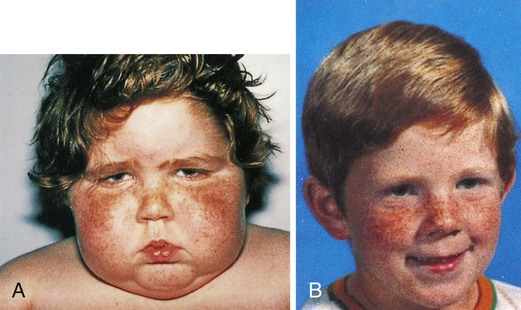
A, First diagnosed with Cushing’s syndrome. B, Four months later after treatment.

 -year-old boy is in the 50th percentile for height. The short, 3-year-old girl exhibits the characteristic “kewpie doll” appearance, suggesting a diagnosis of growth hormone (GH) deficiency.
-year-old boy is in the 50th percentile for height. The short, 3-year-old girl exhibits the characteristic “kewpie doll” appearance, suggesting a diagnosis of growth hormone (GH) deficiency.
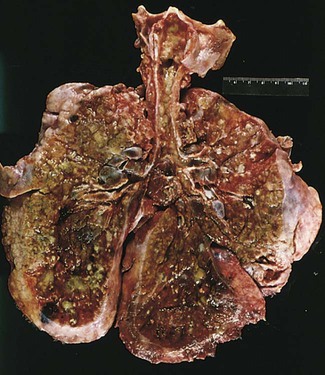
Term
Word Origin
Definition
anorexia
an- no, not, without
orex/o appetite
-ia condition
Lack of appetite. Anorexia nervosa is an eating disorder.
glycosuria
glycos/o sugar, glucose
-uria urinary condition
Presence of glucose in the urine. May indicate diabetes mellitus. Also called glucosuria.
hyperalimentation
hyper- excessive, above
aliment/o nutrition
-ation process of
An excessive intake of food. May be used to describe overeating.
hyperglycemia
hyper- excessive, above
glyc/o glucose, sugar
-emia blood condition
Excessive glucose in the blood.
ketonuria
keton/o ketone
-uria urinary condition![]()
Stay updated, free articles. Join our Telegram channel

Full access? Get Clinical Tree

 Get Clinical Tree app for offline access
Get Clinical Tree app for offline access

